Day 2 of a three day Early Autumn Tour today. It was a grey start, brightening up, with some spells of sunshine and blue sky, but it was very windy, with a very strong NW wind which eased off a touch in the afternoon. At least it was dry today, and we made the most of it.
To start the day, we drove east along the coast road to Kelling. As we pulled up in the village, a Red-legged Partridge flew out of one of the driveways, across the road behind us and away over the school. Walking up the lane, we heard several Chiffchaffs and Blackcaps calling in the hedges, most likely local birds rather than migrants. There were a few Chaffinches and Robins too. A Common Buzzard hung in the wind over Muckleburgh Hill, and was mobbed by a couple of passing Rooks, but just shifted a wing nonchalantly to evade them.
When we got to the gates by the copse, we spotted a Green Sandpiper down in the pool in the wet grass. A second Green Sandpiper called and dropped in nearby, flashing dark with a contrasting white tail and belly, but it was immediately chased off by the first, which then flew round and landed back down on the pool. There were several Common Snipe hiding down in the wet grass closer to us too. They were surprisingly hard to see, crouched down in the holes left by the cows’ footprints, but as they moved round we counted eleven in total.
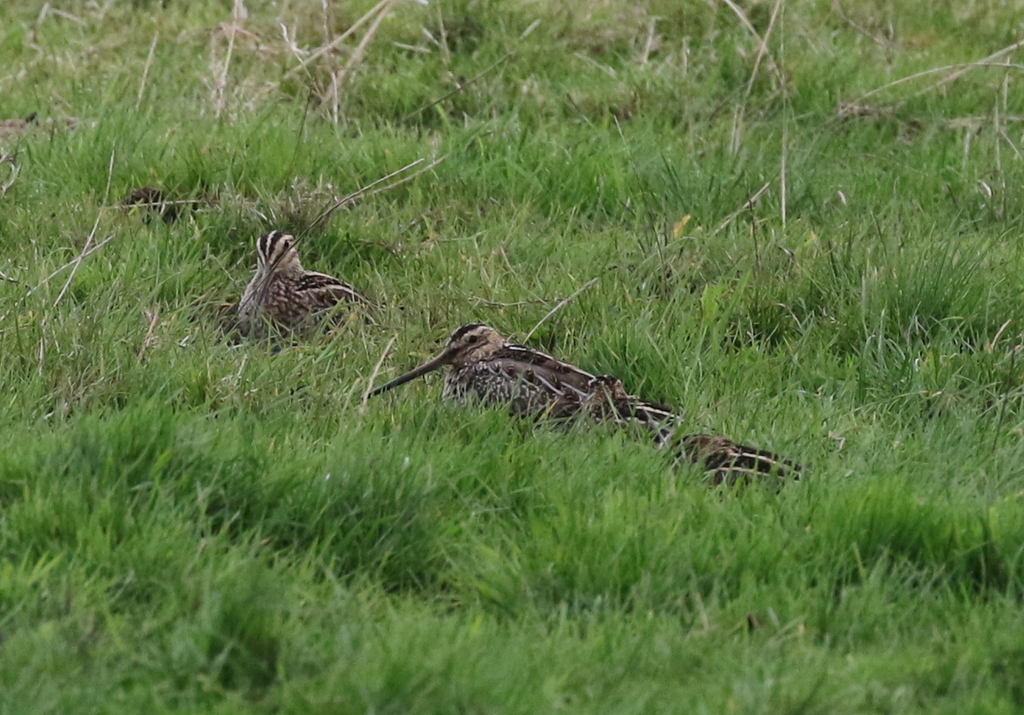
We carried on down to the pool on the Water Meadow. There were lots of gulls on the water, huddled up against the north edge trying to get out of the wind, but they were just Black-headed Gulls and a few Herring Gulls. Three Sand Martins were skimming backwards and forwards low over the water, looking for insects.
There were several ducks on the pool, Teal, Gadwall and a lone Shoveler as well as six Egyptian Geese, including the resident pair with their two fully grown young still. But a couple came down with two dogs, which started yapping at us as they passed, and then still barking as they walked along the cross track and they managed to flush most of the ducks.
Scanning the bushes beyond the Quags from the cross track, we could see several Stonechats up on the hillside, on the edge of the cattle field, so we walked round for a closer look. The Stonechats were dropping down from the brambles or the barbed wire to the ground to look for food in the short grass. They had found a relatively sheltered spot in the lee of the fence line.
There were wore Stonechats in the brambles and long grass beyond the fence. A paler bird with them hopped up onto a curl of bramble, a Whinchat. We got it in the scope, noting its pale supercilium and pale peachy orange wash on its breast, much paler overall than the female Stonechats. All the birds were keeping well down in the vegetation, trying to get out of the wind, but we found a second Whinchat a little further over when it popped up briefly. Whinchats are just passage migrants here, stopping off on their way south.
As we continued down past the Quags, we heard a Swallow alarm calling, and looked over to see a young Sparrowhawk shoot fast and low over the grass. We walked up the path up to the gun emplacements. The bushes down by the beach were quiet today. A couple of Swallows were still lingering around the gun emplacements, and there were a few Pied Wagtails in field with cows.
We looked out to sea from the high point here. With a strong northerly wind, we had expected to see some birds moving offshore today, but we couldn’t see anything apart from a few Sandwich Terns. We walked back down and climbed up onto the shingle ridge. It was a rough sea today, whipped up by the wind, and we watched the waves crashing on the beach. A distant Gannet flew past.
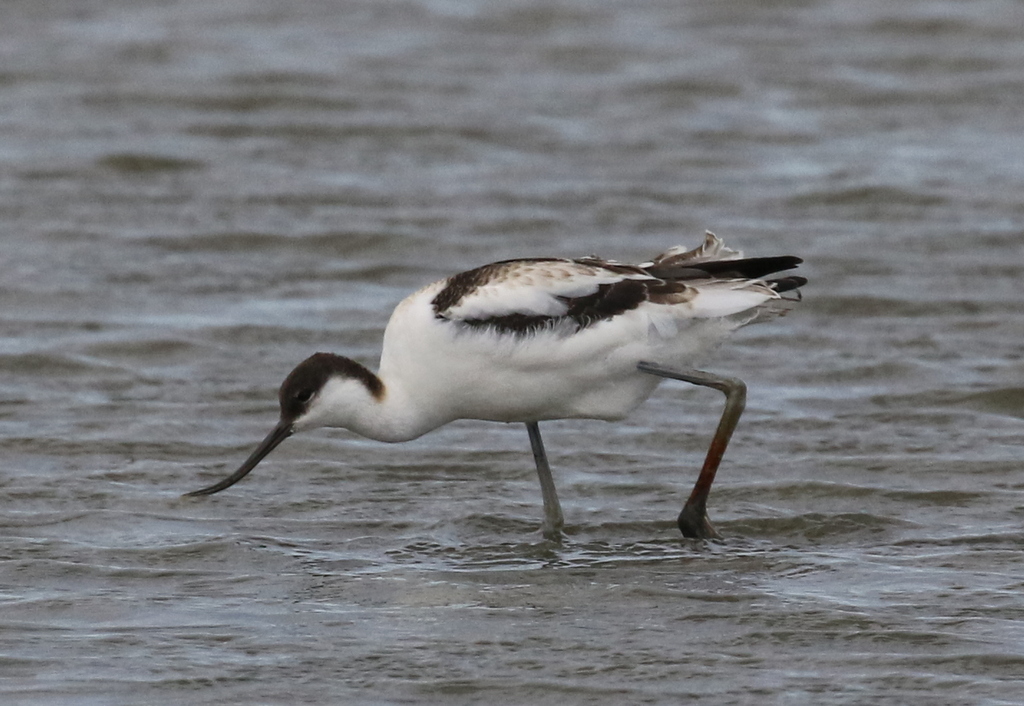
After walking back up the lane, we drove round to Cley next. We thought we would try to get out of the wind in the hides. We called in to Bishop Hide first, where there were a few Avocets still on Pat’s Pool, including a juvenile feeding close to hide.
There were fewer Black-tailed Godwits on here than normal, possibly due to the wind, but those that were here were over in the far corner by the reeds. Two slightly smaller birds asleep in the water next to them were Spotted Redshanks. We had a look at them through the scope, two dusky grey juveniles. After a while they woke up and started preening, so we could see their long, needle-tipped bills.
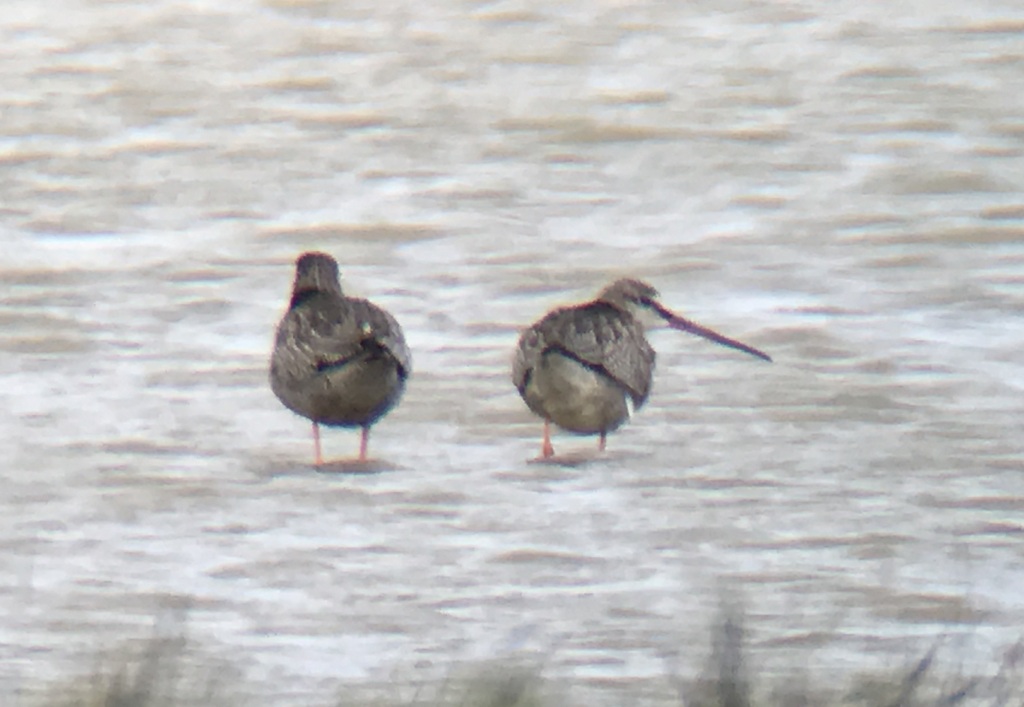
We could see a couple of little groups of Dunlin on the mud right over the far side. Two Bar-tailed Godwits were over with them, paler and with more patterned upperparts than the Black-tailed Godwits, and with a slight upturn to their long straight bills. A Green Sandpiper flashed across in front of the hide and a Water Rail squealed from somewhere in the reeds.
As we set off to walk round to the main hides, we could hear Bearded Tits calling in the reeds close to path. We stopped to look, but the reeds were being lashed from side to side by the wind, so it was pretty clear they would not be coming out.
When we got out into the middle, we had a quick look in Avocet Hide. The mud on Whitwell Scrape is quickly drying out now, and there was nothing to see, no sign of any of the Green Sandpipers which have been on there for much of this week. However, just as we got into Dauke’s Hide, a Green Sandpiper flew past and landed on back on one of the remaining pools, where we had just looked on Whitwell Scrape, with a Common Redshank.
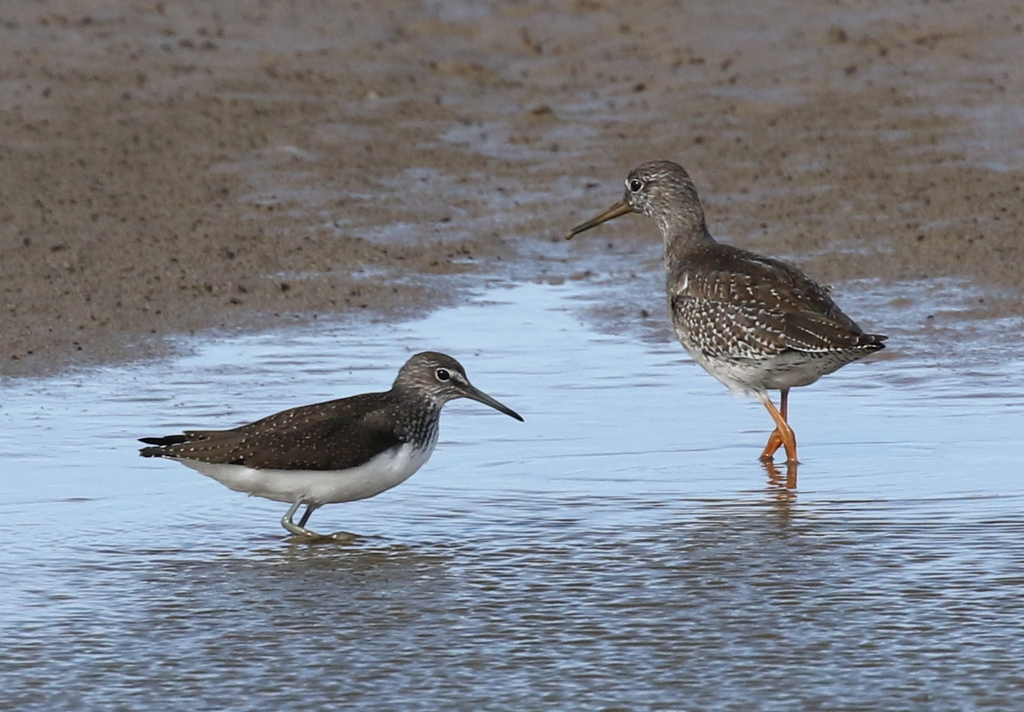
Simmond’s Scrape was a bit windswept today and was consequently a little disappointing. Three juvenile Black-tailed Godwits were feeding in deeper water in front of hide, Icelandic birds with an orangey wash on their necks.
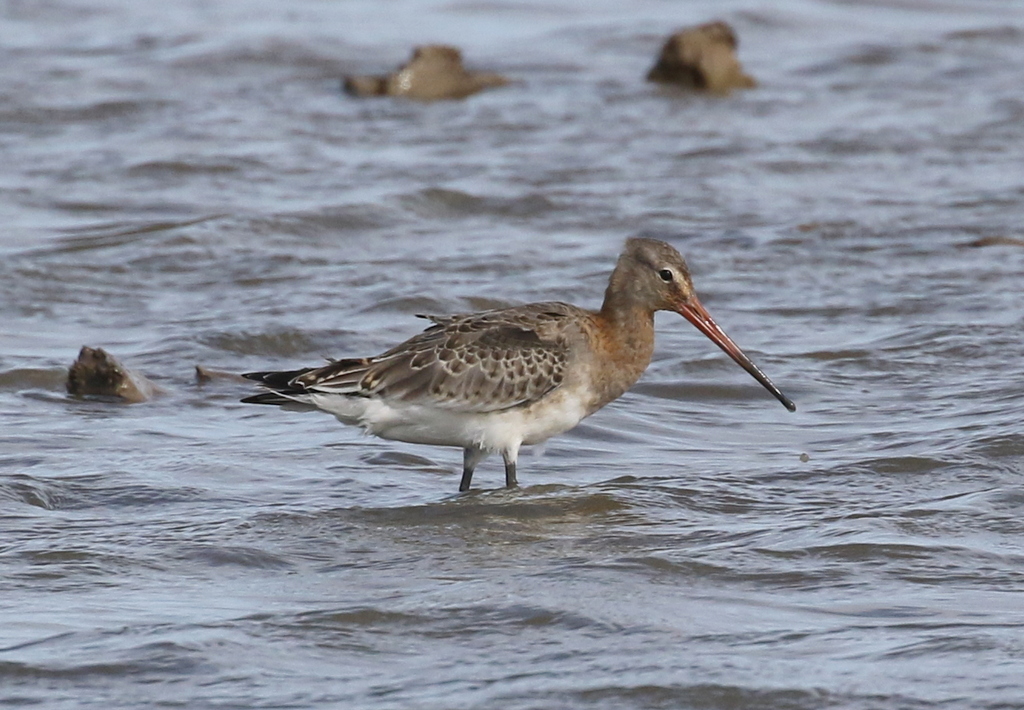
The waders which were here were very flighty today, often the case in the wind. We couldn’t see the Spotted Redshanks on Pat’s Pool now, but at one point they flew back in past the hide, over the scrape and disappeared off over the reeds. The Dunlin were very jumpy too, mostly hidden up behind the reeds on the edge of Pat’s, but they kept flying out into the middle and back in again.
There were clearly a few waders moving today, migrants arriving. As we sat in the hide, we heard a Greenshank calling and looked over to see it drop down on Simmond’s Scrape. We had a look at it through the scope – it was a distinctive bird, already with a few greyer winter scapulars.
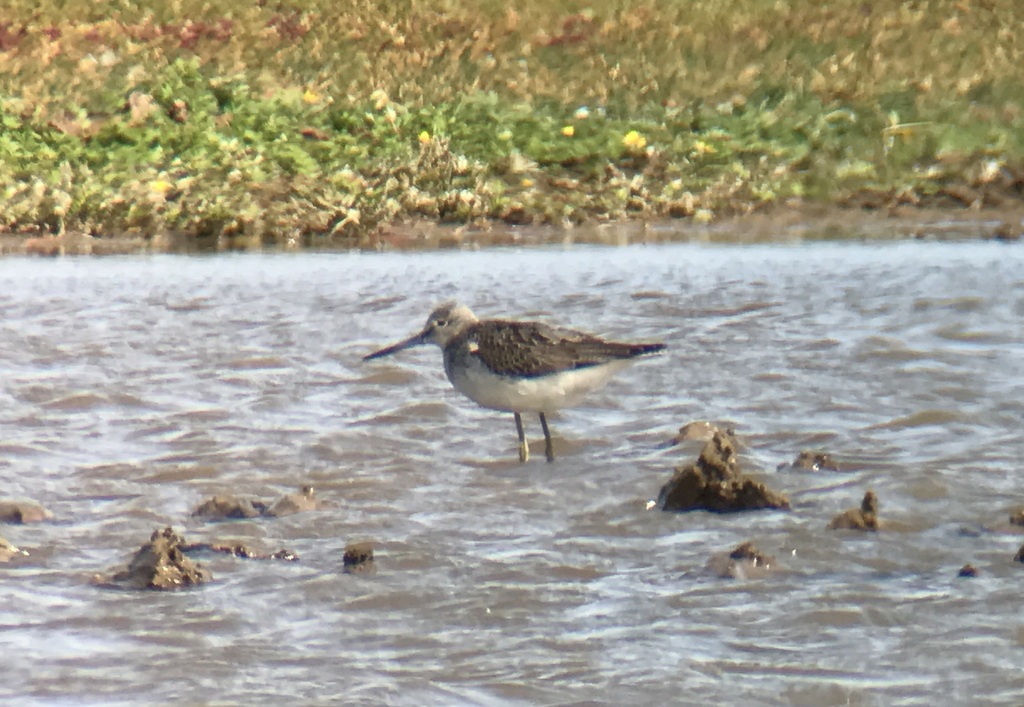
It was time for lunch, we we walked back to the Visitor Centre. The sun was out, and we managed to find a sheltered spot out of the wind. After lunch, the wind seemed to have dropped a little, so we thought we might brave the East Bank.
We drove round and parked at Walsey Hills. There were just a couple of Teal on Snipe’s Marsh today, not even any sign of the resident Little Grebe. We walked over to the East Bank, and found a Little Grebe on Don’s Pool instead. A Curlew flew over the grazing marsh calling but there was no sign of the flock out in the grass today. Pope’s Pool at the back was dry now, but there was still water in the Serpentine so we continued up for a look.
There were a few Avocets along the shore of the Serpentine, along with one or two Redshanks and several Shelducks. There were more birds along the north edge where it was a bit more sheltered, in the lee of the reeds. We could see a small group of about twenty Dunlin scattered round, feeding in the mud and shallow water, and five Common Snipe with them. We we walked up and looked through them closely, we found a single juvenile Curlew Sandpiper in with them. There had been no reports of Curlew Sandpiper at Cley in the last few days, so it had presumably just dropped in here to feed.
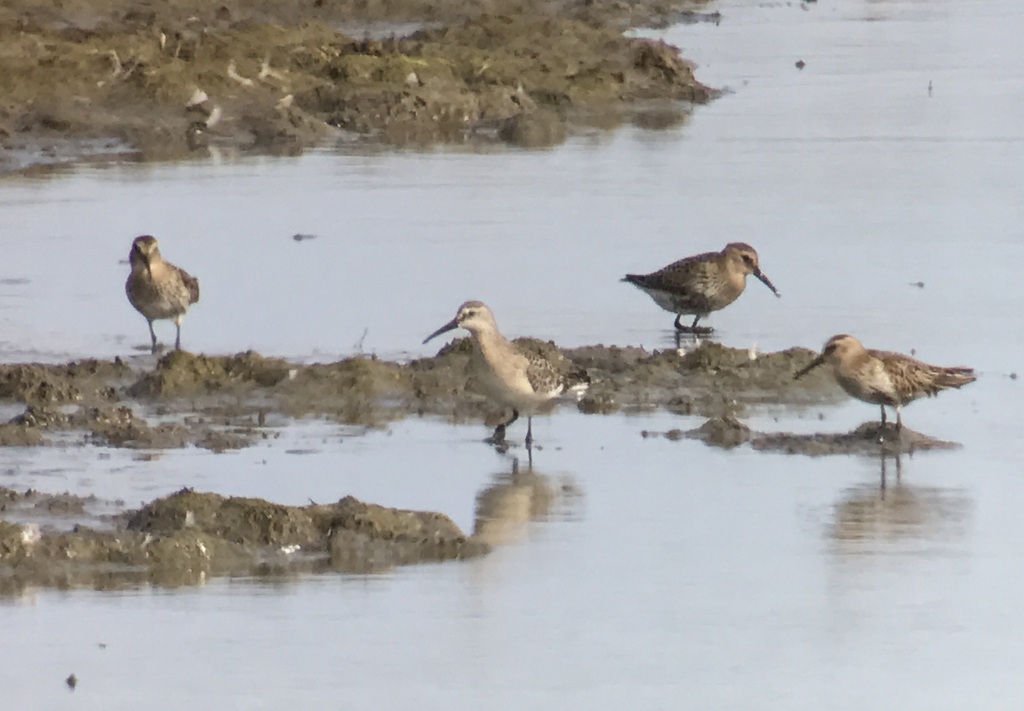
The shelter at Arnold’s Marsh provided a welcome respite from the wind. There were lots of Sandwich Terns roosting out on the marsh, but they were very jumpy and kept taking off, flying round and settling again. All the Curlews were on here, roosting on the saltmarsh over in the back corner. Otherwise, all we could see were a scattering of Common Redshank.
Quite a few Wigeon in huddled groups out on the water were possibly fairly fresh in, coming back from Russia for the winter. We watched a small group of six Teal battling in along the shingle ridge, buffeted by the wind.
We decided to brave the beach, and have a quick look out to sea. As we walked up along the bank, a couple of Little Egrets were down on the brackish marsh and a Grey Heron had found a sheltered spot in the sun out of the wind behind the marram grass. One or two Meadow Pipits came up out of grass calling but dropped back in.
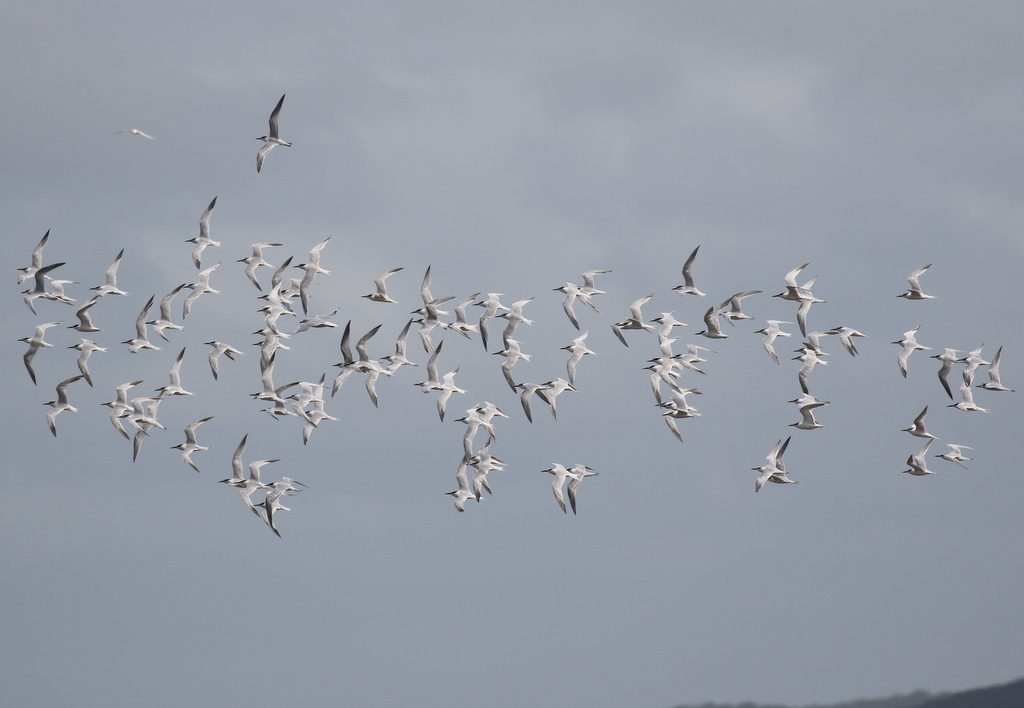
The Sandwich Terns all spooked again, but this time after circling round they flew out over the shingle ridge to the sea. When we got to the beach, we could see some feeding offshore, but many obviously didn’t fancy the weather and the choppy sea and headed straight back in to Arnold’s.
Scanning offshore, we picked up three very distant Arctic Skuas busy chasing terns offshore. Another two Arctic Skuas flew past a little closer in, and one turned and came straight in towards us. It had seen a Sandwich Tern nearer to us and started to chase after it. We watched as they twisted and turned, but the tern quickly gave up and dropped whatever it was carrying. The Arctic Skua dropped down to the water’s surface and picked it up, before flying back out and continuing on its way west. The skuas are kleptoparasites, feeding by stealing the food of other seabirds. The pirates of the North Sea!
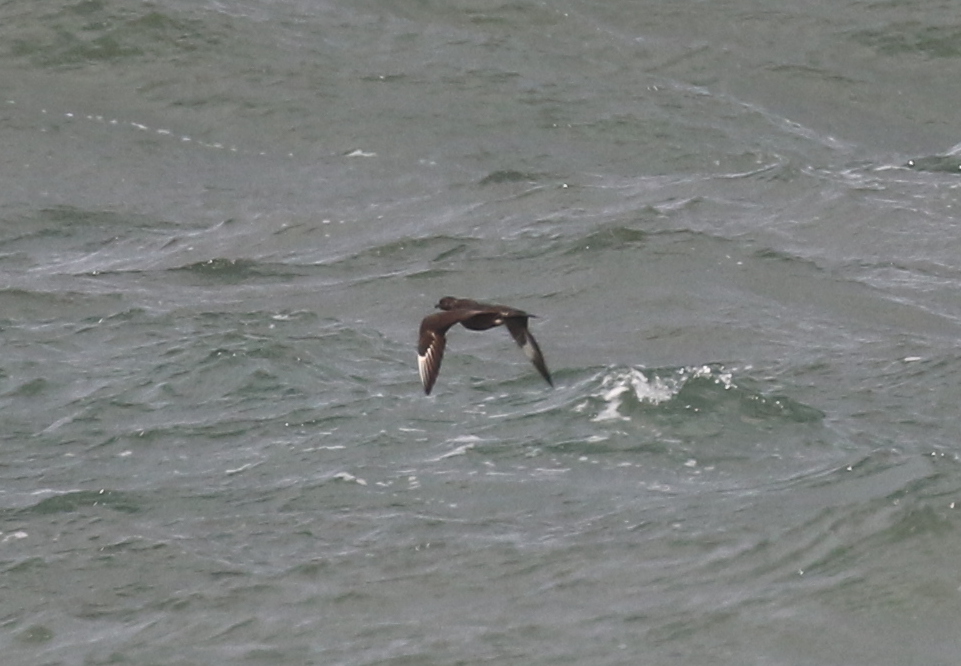
Three Gannets flew past offshore, two white adults with black wingtips and a darker-winged immature. A Fulmar came past too, low over the waves, with stiff wings. It was too windy to stay out here long, so after enjoying the spectacle for a bit we turned to head back in.
As we got back towards the road, a big flock of noisy Greylags flew in over the grazing marshes. They had clearly just been flushed by a microlight aircraft which came over just behind them, flushing everything. A small group of eight darker geese, Pink-footed Geese, flew over too. They seem to be a little early returning from Iceland this year and it was surprising how many small groups we had seen.
We decided to try to get out of the wind inland to finish the afternoon, so we drove down to the Brecks. We wanted to make the pilgrimage to see the annual post-breeding gathering of Stone Curlews, which peaks at this time of year. We pulled up by their favoured field, and peaked over the hedge, careful to not disturb any close by. Immediately we could see six Stone Curlews hunkered down behind line of earth and weeds in field.

We had a great view of the Stone Curlews in the scope, their bright yellow irises catching the sun. They were amazingly well camouflaged, the colour of the sandy soil. Then we scanned the rest of the field and counted at least twenty. There were probably a lot more we couldn’t see, with the birds tucked down out of the wind, and lots of dead ground in the field where they could hide out of view. With only around 200 pairs nesting in the East of England, even 20 is an impressive total! A large group a Lesser Black-backed Gulls was loafing in field too.
It was well worth the diversion down to see the Stone Curlews, and a nice way to end the day. It was time to head back – a good chance for a doze in the back!
















